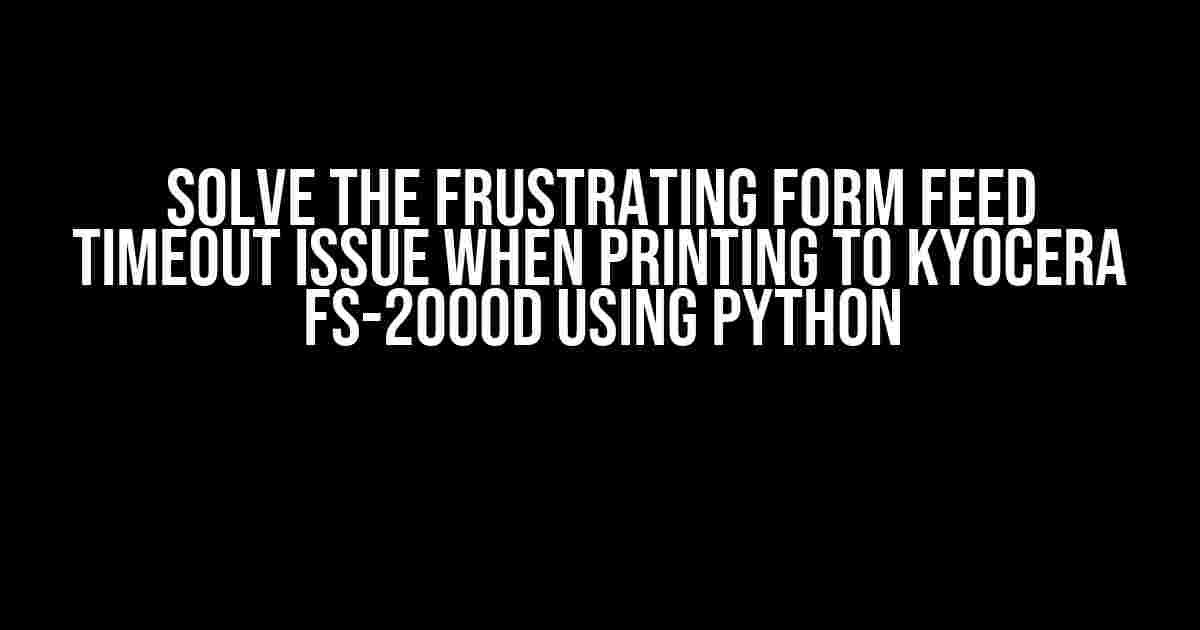Are you tired of dealing with the pesky form feed timeout error when trying to print to your trusty Kyocera FS-2000D printer using Python? Well, you’re in luck! In this comprehensive guide, we’ll delve into the world of printing with Python and provide you with clear, step-by-step instructions to overcome this annoying issue once and for all.
What is a Form Feed Timeout?
A form feed timeout occurs when the printer doesn’t receive the expected form feed character (FF) within a specified time period, causing the printing process to timeout and fail. This can happen when printing to the Kyocera FS-2000D printer using Python, especially when dealing with large prints or complex documents.
Why Does the Form Feed Timeout Occur?
There are several reasons why the form feed timeout might occur when printing to the Kyocera FS-2000D using Python:
- Incorrect Printer Settings: Misconfigured printer settings, such as incorrect paper sizes or orientations, can lead to form feed timeout issues.
- Insufficient Printer Buffer: The Kyocera FS-2000D printer has a limited buffer size, which can cause issues when printing large documents or complex prints.
- Slow Data Transfer: Slow data transfer rates between the Python script and the printer can result in form feed timeouts.
- Python Script Issues: Errors or inefficiencies in the Python script itself can cause the form feed timeout issue.
Solving the Form Feed Timeout Issue
Now that we’ve identified the possible causes, let’s dive into the solutions! Follow these steps to overcome the form feed timeout issue when printing to the Kyocera FS-2000D using Python:
Step 1: Check and Configure Printer Settings
Ensure your printer settings are correctly configured:
import cups conn = cups.Connection() printers = conn.getPrinters() # Select the Kyocera FS-2000D printer printer_name = "Kyocera_FS-2000D" # Get the printer's default settings printer_defaults = conn.getPrinterAttributes(printer_name) # Set the paper size and orientation printer_defaults["media"] = "A4" printer_defaults["orientation"] = "portrait" # Update the printer settings conn.setPrinterAttributes(printer_name, printer_defaults)
Step 2: Increase the Printer Buffer Size
Expand the printer buffer size to accommodate larger prints:
import cups
conn = cups.Connection()
# Get the current printer buffer size
buffer_size = conn.getPrinterAttribute("Kyocera_FS-2000D", "buffer-size")
# Increase the buffer size (in bytes)
new_buffer_size = buffer_size * 2
# Update the printer buffer size
conn.setPrinterAttribute("Kyocera_FS-2000D", "buffer-size", new_buffer_size)
Step 3: Optimize Data Transfer
Improve data transfer rates by using a more efficient printing method:
import cups
import os
conn = cups.Connection()
# Create a temporary file for the print job
temp_file = "print_job.tmp"
# Open the file in binary write mode
with open(temp_file, "wb") as f:
# Write the print data to the file
f.write(b"This is the print data")
# Send the print job to the printer
conn.printFile("Kyocera_FS-2000D", temp_file, "Print Job")
# Remove the temporary file
os.remove(temp_file)
Step 4: Optimize the Python Script
Refactor your Python script to handle printing more efficiently:
import cups
import time
conn = cups.Connection()
# Define a function to print a single page
def print_page(page_data):
# Create a temporary file for the page
temp_file = "page.tmp"
# Open the file in binary write mode
with open(temp_file, "wb") as f:
# Write the page data to the file
f.write(page_data)
# Send the page to the printer
conn.printFile("Kyocera_FS-2000D", temp_file, "Page")
# Remove the temporary file
os.remove(temp_file)
# Define the print job data
print_job_data = [b"Page 1 data", b"Page 2 data", b"Page 3 data"]
# Print each page separately
for page in print_job_data:
print_page(page)
# Add a small delay to prevent buffer overflow
time.sleep(0.5)
Troubleshooting Tips
If you’re still experiencing issues, try these troubleshooting tips:
- Check the printer’s error log: Review the printer’s error log to identify any specific error messages or clues.
- Verify the Python script: Ensure your Python script is correctly configured and error-free.
- Test with a different printer: Try printing to a different printer to isolate the issue.
- Consult the Kyocera FS-2000D manual: Refer to the printer’s manual for specific settings and troubleshooting guidelines.
Conclusion
With these comprehensive steps and troubleshooting tips, you should be able to overcome the form feed timeout issue when printing to the Kyocera FS-2000D using Python. Remember to carefully configure your printer settings, optimize data transfer, and refactor your Python script for efficient printing. Happy printing!
| Tip | Description |
|---|---|
| Use the correct paper size | Ensure the paper size in your Python script matches the paper size set on the printer. |
| Monitor printer buffer size | Regularly check the printer buffer size to prevent overflow and form feed timeouts. |
| Optimize Python script | Refactor your Python script to handle printing efficiently and prevent form feed timeouts. |
By following these best practices and troubleshooting tips, you’ll be well on your way to resolving the form feed timeout issue and enjoying seamless printing with your Kyocera FS-2000D and Python.
Frequently Asked Question
Hey there, Python enthusiast! Are you having trouble printing to your Kyocera FS-2000D using Python and running into a form feed timeout? Don’t worry, we’ve got you covered! Check out these frequently asked questions to get your printing issues sorted out.
What is a form feed timeout when printing to Kyocera FS-2000D using Python?
A form feed timeout occurs when the printer takes too long to process a print job, resulting in a timeout error. This can happen when the printer is busy, out of paper, or experiencing technical difficulties.
What are the common causes of form feed timeout when printing to Kyocera FS-2000D using Python?
Common causes include incorrect printer settings, outdated printer drivers, slow network connections, and printer hardware issues. Additionally, using an incompatible printing library or incorrect Python code can also lead to form feed timeouts.
How can I troubleshoot form feed timeouts when printing to Kyocera FS-2000D using Python?
Start by checking the printer’s status, updating printer drivers, and ensuring a stable network connection. You can also try adjusting the print speed, paper size, and orientation in your Python code. If issues persist, try using a different printing library or seek help from the Kyocera support team.
Can I increase the timeout period when printing to Kyocera FS-2000D using Python?
Yes, you can increase the timeout period by modifying the printer settings or using a printing library that allows timeout adjustments. For example, you can use the `timeout` parameter in the `win32print` library to set a longer timeout period.
Are there any alternative printing libraries that can help avoid form feed timeouts when printing to Kyocera FS-2000D using Python?
Yes, alternatives include `pycups`, `python-printer`, and `escpos`. These libraries provide more flexibility and customization options for printing, which can help reduce the likelihood of form feed timeouts. Be sure to check the compatibility of these libraries with your Kyocera FS-2000D printer model.




